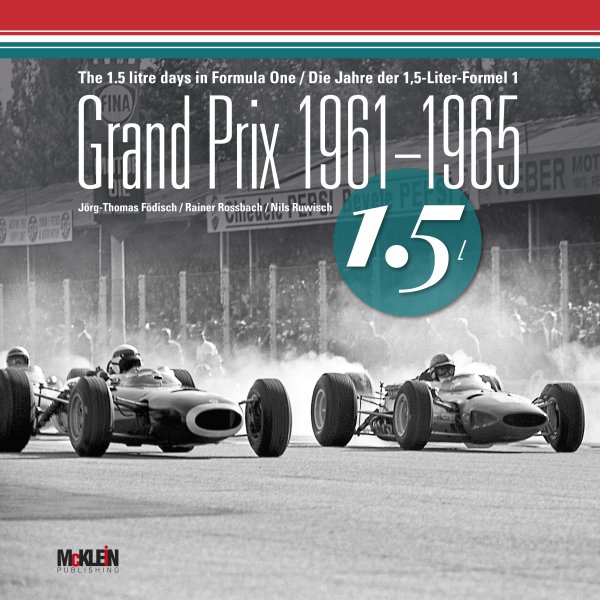Grand Prix 1961-1965 — Die Jahre der 1,5-Liter-Formel 1 / The 1.5 litre days in Formula One
Prices incl. VAT plus shipping costs
Free of shipping costs inside Germany
Ready for immediate shipment
Delivery time appr. 1-3 workdays (inside Germany)
- ISBN-10: 3947156278
- ISBN-13: 9783947156276
von Jörg-Thomas Födisch, Rainer Rossbach und Nils Ruwisch
Ab dem 1. Januar 1961 galt in der Formel 1 ein neues technisches Reglement. Nun mussten Motoren mit 1,5 Litern Hubraum reichen, denn die Geschwindigkeiten sollten reduziert werden. Erlaubt waren jetzt Rennwagen mit Saugmotoren und maximal 1,5 Litern Hubraum. Die Motorleistung betrug zunächst 150 PS, am Ende der Epoche mehr als 220 PS. Zunächst unterschätzte man die Formel 1-Rennwagen jener Zeit, was den Leistungen der Techniker und der Fahrer nicht gerecht wurde: denn um die Autos am Limit zu bewegen, war größtes fahrerisches Können erforderlich.
Die britischen Teams hatten zunächst gegen die neuen Regeln opponiert und gingen mit einem technischen Rückstand in die neue Formel 1. Ferrari war besser gerüstet: Die Scuderia gewann 1961 sowohl die Fahrer- als auch die Konstrukteurs-Weltmeisterschaft und konnte den Erfolg 1964 wiederholen. Genauso erfolgreich war Lotus mit dem überragenden Jim Clark, und auch BRM-Pilot Graham Hill gelang ein Titelgewinn.
Nachdem die Briten mit dem Climax-V8 motorisch Anschluss fanden, wies Lotus mit dem Typ 25, dem ersten Monocoque-Formel 1, den Weg in die Zukunft.
Die 1,5-Liter-Formel hat mit Stirling Moss, Graham Hill, John Surtees, Dan Gurney, Jim Clark und Jackie Stewart einige der besten Piloten aller Zeiten gesehen - und trotz aller Unkenrufe, die „neue“ Formel 1 könne mangels Hubraum und Leistung nicht spannend werden, wurde aufregender Sport geboten.
Auch für die Zuschauer waren die Großen Preise ein echtes Spektakel, weil sie ganz nah am Geschehen waren.
Jörg-Thomas Födisch, Rainer Rossbach und Nils Ruwisch zeigen im diesem Buch mit vielen unveröffentlichten Aufnahmen - die meisten auf dem Archiv von Bernard Cahier - die ganze Faszination der 47 Grands Prix, die zur Fahrer-Weltmeisterschaft nach den Regeln der 1,5-Liter-Formel zählten.
From January 1st, 1961, a new set of technical regulations were applied in Formula One. From that date, all the naturally aspirated engines had to be of a maximum displacement of 1.5 litres in an attempt to reduce the speeds. The power of these engines was initially about 150 bhp though, at the end of the era, this had risen to more than 220 bhp. At first the Formula One cars of that time were underestimated, which was being unfair to the achievements of the engineers and of the drivers involved. To operate these cars at their limits demanded a high level of driver skill.
Initially the British teams had opposed the new rules and thus entered the new Formula One at a technical disadvantage. Ferrari was better equipped with new 1.5 litre engines and thus the Scuderia won both the Driver and the Constructor Championships in 1961 and was able to repeat this success in 1964. Lotus was just as successful with the outstanding Jim Clark, and BRM driver Graham Hill also won the title. After the British had caught up with engines like the Climax V8, Lotus also pointed the way into the future with the Type 25, the first monocoque Formula One car.
The 1.5 litre formula saw the participation of some of the best Formula One drivers of all time with Stirling Moss, Graham Hill, John Surtees, Dan Gurney, Jim Clark and Jackie Stewart. And despite all the prophecies of doom that the "new" Formula One would not be exciting thanks to a lack of engine power, some thrilling sport was on offer during this five-year period. These Grands Prix were also a real spectacle for the spectators, because they were very close to the action.
Jörg-Thomas Födisch, Rainer Rossbach and Nils Ruwisch reveal in this book - using many previously unpublished photographs of which most are taken from the Bernard Cahier archive - the attraction and excitement generated by the forty-seven Grands Prix that constituted the World Championships for Drivers under the 1.5-litre Formula One regulations.
Buch, Hardcover im Schuber, 29 x 29 cm, 360 Seiten, 220 farbige und 325 s/w-Abbildungen, zweisprachiger Text (deutsch/englisch)

























